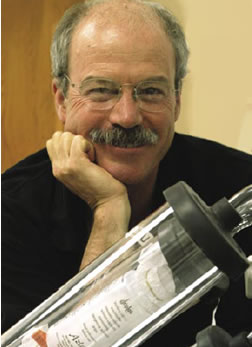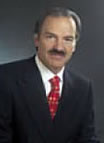
Vol. 15 No. 2 |
Fall 2005 |
BY LUCY BURNINGHAM - PHOTO BY LANCE W. DUFFIN
Turning good ideas into good business
Someone dubbed it “Prestwigel,” and the name stuck. Technically, the substance is called Carbylan, but today everyone is calling it “Prestwigel.”
A few students, medicinal chemistry professor Glenn Prestwich, and members of Prestwich’s lab huddle around a table in the U’s Lassonde New Venture Development Center, trying to figure out how to convince the medical world that Prestwigel will be just the thing to heal chronic wounds, prevent internal scar tissue after surgery, and repair bone and cartilage.
 |
| Professor
and inventor " IT'S GOING TO BE A MONEYMAKER AND A PEOPLE HELPER." |
Prestwich is here because the Lassonde Center, part of the David Eccles School of Business’ Utah Entrepreneur Center and the brainchild of Pierre Lassonde MBA’73, brings together students from the business school with undergraduate and graduate students in the sciences to act as a unique educational Petri dish. Teams of two to five students are assigned projects at the beginning of a semester—scientific discoveries from the U of U with licensing potential that may or may not already have patents—and begin tearing through information about the technology and its commercial prospects. Students in the sciences, who usually have so background in the technology they research, learn to explain the project in layman’s terms to the business students. In return, the business students provide basic knowledge about market analysis, barriers to entry, and profit margins.
Prestwich is no stranger to innovation. In 1997, he helped to launch Echelon Biosciences Inc., now a multimillion-dollar company located in Research Park. He formed Sentrx Surgical with Richard Koehn, Richard Orlandi BS’87, and Albert Park to develop and produce this new gel after his invention was rejected for a grant. Although the rejection stung, the grant committee had raised some questions about this new gel: Did it have patent potential? Would it be able to penetrate the market?
These are the questions Prestwich brought to the Lassonde Center.
It’s one thing to make a scientific discovery, still another to form a start-up venture without some help. Lassonde Center Director Troy D’Ambrosio compares the U’s scientific discoveries to new babies, with the scientists as proud parents. “Parents always think their child is the cutest,” he says, “so it’s our job not to get caught up in that emotion, but to present a rational approach.”
In a couple of cases, the Lassonde Center has had to tell the researcher either that his or her “invention” was too similar to other products on the market or that it simply didn’t have the potential for success. But according to the program’s aims, an informed rejection holds as much value as a validation.
Prestwich understands the process well—he sent his hydrogel through the Lassonde Center wringer once before. The first time through, a team of two science and two business students looked at various applications for the biocompatible, synthetic substance, analyzing the market potential for an easy to handle, long-lasting, water-based gel with many clinical applications, including sinus surgeries. That first Lassonde team essentially gave the gel a green light, and Sentrx Surgical went on to receive three Small Business Technology Transfer Research awards from the National Institutes of Health, while the gel took first place for innovation in chemistry at the 2005 Utah Innovation Awards.
| Who is Pierre Lassonde?
Lassonde decided to help create the center after the death of his wife, Claudette MS’73. They both attended the U, Lassonde studying business, Claudette nuclear engineering. Like the couple themselves, Lassonde’s center brought together science and commerce. “When we were thinking about giving a gift to the University, we wanted to marry the technical and innovative scientific talent to the business school, and let all participating students have an experience they would never get otherwise,” he says. In addition to his degree from the U, Lassonde has a B.A. from Seminaire de St. Hyacinthe of the University of Montreal and a bachelor’s degree in electrical engineering from Montreal’s Ecole Polytechnique. Now, as president of Newmont Mining Corporation, and with more than 25 years of experience in the gold mining business, he is considered Canada’s leading gold analyst. Looking to the future, Lassonde says he hopes to garner funding to move the center to its own building in Fort Douglas and attract even more top students from around the world. “In 20 years, if the president of Morgan Stanley has been through the Lassonde Center, we will have reached the height of honor,” he says. “We must continue to upgrade the quality of the program and get the best students.”
|
At today’s meeting, starting his second round with the Lassonde Center, Prestwich has called on the group to help him with Prestwigel, and he has instructed the three students to investigate the gel’s potential as a medium for scientific research. As a culture, the substance could allow scientists to better evaluate growths outside of animals and humans, which could revolutionize cancer drug research. “It’s going to be a moneymaker and a people helper,” Prestwich says.Prestwich adds his two-cents’ worth or cracks an occasional joke here or there, but for the most part the students are running the show.
Brad Stoker, a graduate student in bioengineering, presents head-to-head comparisons of competitors. Prestwigel surpasses many of the competitors’ products as a purely synthetic medium, which creates more consistent physiological results during research. Also, the gel has a long shelf life and costs less than most of the others.
Eventually, all conversation focuses on one competing company that seems to be actively seeking new technology and could use something like Prestwigel. (“Did you sense the ‘aha!’ moment?” Stoker later asks.) Prestwich wraps up the meeting by asking for more investigation into the prospective company and other market profiles.
Lassonde director D’Ambrosio attends all meetings for each project, overseeing students’ progress and keeping them on track. Without any organized classes, the program requires curious, self-motivated students, and a good amount of D’Ambrosio’s intellect—he must learn the science behind each project every semester. And each technology requires a new approach. “Every project arrives at a different stage,” D’Ambrosio says.
“But our first priority is the student experience. Secondly, we help the University in the commercialization process.” The priorities seem straight to Prestwigel Lassonde team member David Dunn, a civil engineering undergraduate student who’s considering a career as a patent attorney after the experience. “The real value is in the process,” Dunn says. “It’s a marketable skill that is steering me in the career choices I’m making.”
Prestwich walks away from his second Lassonde experience with the team’s recommendation that he validate his product before trying to sell it to a distributor. Weeks later, Prestwich and his Sentrx Surgical colleagues presented Prestwigel to the American Association for Cancer Research.
“We had an enormous response,” Prestwich reports, with close to 90 requests for more information or samples.“Prestwigel” has cleared some significant hurdles, and seems well on its way to becoming a viable, profitable product. Soon, Prestwich will produce a batch of the hydrogel and distribute it to interested researchers. Then, he hopes for a big contract with a distributor, something he wouldn’t have dreamed of after the grant rejection two years ago. “Because of the research from the Lassonde Center,” says Prestwich, “we now have a strategy.”
—Lucy Burningham is a freelance writer based in Salt Lake City.
 When
Pierre Lassonde MBA’73 donated $3 million to the U in 2000
to start a center that combined business and science, he wasn’t
sure how the University community would receive the idea. “We
didn’t know if the program would get traction,” he says,
“and we had a fair amount of resistance from the scientists
who were worried about exposing their new technologies.” But
five years later, Lassonde takes pride in the center that bears
his name. “I really like the way the program is going,”
he says. “While the big guns at Stanford and MIT have entrepreneurial
centers, ours tackles early stage projects, and there’s nothing
else like it in the U.S.”
When
Pierre Lassonde MBA’73 donated $3 million to the U in 2000
to start a center that combined business and science, he wasn’t
sure how the University community would receive the idea. “We
didn’t know if the program would get traction,” he says,
“and we had a fair amount of resistance from the scientists
who were worried about exposing their new technologies.” But
five years later, Lassonde takes pride in the center that bears
his name. “I really like the way the program is going,”
he says. “While the big guns at Stanford and MIT have entrepreneurial
centers, ours tackles early stage projects, and there’s nothing
else like it in the U.S.”